- JP
- EN

Takeshi Harada will hold a solo exhibition starting Friday, August 21.
We spoke with him!
–What is the theme of this exhibition?
It is various expressions and nostalgic viewpoints by metal.
The subtitle “Nostalgia” means “nostalgic feelings”, which is also the theme of my work.
I hope that through my work, people will feel the same kind of casual discovery and joy that I felt when I was a child when I looked at plants and animals.
-Gallery SeekSo this is your first solo exhibition in about three years, have your works changed?
In this solo exhibition, I think there are more motifs of incense burners and box-shaped objects that have a use.
I’m expanding the range of things I can do technically.3I hope you can see the details and expressions that were not possible two years ago.In order to put the parts and components into a product that has a use, the accuracy of each part and component is required.
It’s difficult to maintain that level of precision, but I feel that I can now produce with greater precision than before and express more complex shapes.
Also, many of his works are not at first glance recognizable as “objects with a purpose,” such as a box made of bricks or a lid made of a dandelion.
I didn’t want to make the “use” part of the work into an all-encompassing expression, and I hope that when people realize that it’s a “thing with a use”, they will enjoy it.
“Season 〜Dandelion and Lizard Figure Tripod Incense Burner〜” H130×130×130mm Silver, brass, copper, tin, colored foil
–His works are so elaborately made that they could be mistaken for the real thing, down to the small animals and the veins of the leaves, for example.
In the early days, I made more abstract works.
I don’t put any particular emphasis on being realistic in my work.
When I make a work, a clear vision comes to me, but it comes from a former memory, not as an image, but as a still thing.
I think the work was a natural progression from memory to realism.
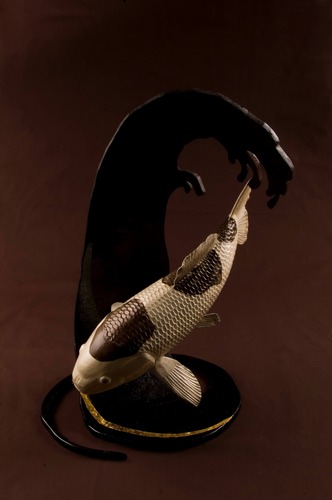
“Sabi – Nishikigoi and the Wave”
–undergraduate (course, program, etc.)4I heard that this was done in the second year of school, but the atmosphere is different again.
How has your awareness of production changed between then and now?
That’s right. The fundamental “theme” and “I’m making what I want to make” haven’t changed between then and now, but I think I’ve become more conscious of whether or not the viewer can understand what I’m trying to convey through my work. Is it simply easy to understand?
–Where do you get inspiration for your work?
I use scenes from my daily life and things I casually find and find interesting as motifs.
I grew up surrounded by nature since my childhood and still live in Akitakada City in Hiroshima Prefecture, where my university was located.
The land is rich in greenery and water resources, including the Eno River, and people have lived in harmony with nature while growing rice paddies.
There are frogs and geckos around my house and home, so I have no trouble finding models for my artwork!((LOL!))
–How did you narrow down the motifs among the many animals?
When I was a child, I was a child who used to play outside with a bug net by myself.
There are many plants and animals that I encountered at that time. I often caught butterflies and dragonflies.
I also kept the insects I caught. We also fed them and observed them.
When I look at insects again as an adult, I think my knowledge of organisms that I didn’t know when I was a child has increased, and the way I enjoy observing them has changed.
–I see. There are many cute works on display this time, such as a wall hanging with ants perched on plum blossoms and a chick on a croissant.
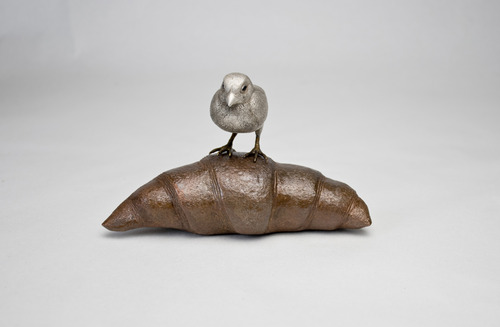
「Mybread」 H95×130×70mm Silver, copper, brass, colored foil
I tried to incorporate an atmosphere that didn’t seem realistic.
The croissant part is shaped with clay in advance to solidify the image.
Etching “Ants and Plum Blossoms”(Techniques of plastic forming or surface treatment using the corrosive action of chemicals, etc.)The expression is expressed in the following way.
It’s a technique that can also be seen in copperplate engraving.
I’ve experimented with it before, but this is the first time I’ve made it into a work of art.
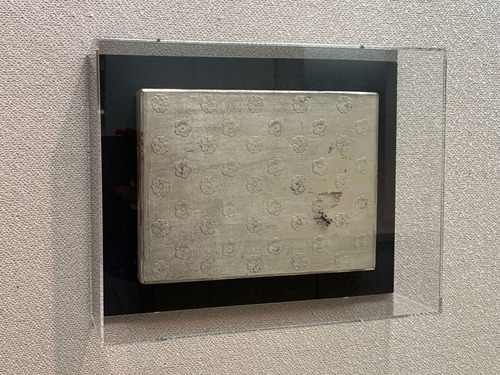
“Ants and Plum Blossoms” H200×260×60mm Copper, brass, gold leaf
-What is the most important work you would like people to see in the exhibition?
The view and the pearl.
In particular, “Pearl” incorporates the texture of rusty and dirty familiar architectural objects into the sphere.
It is an experimental work with abstract expressions, and a challenging work.
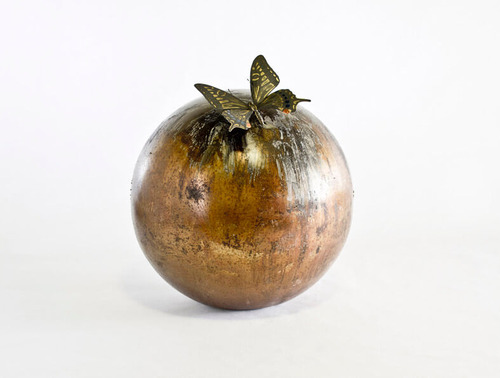
「球」 H330×300×300mm sterling silver, brass, stainless steel, tin, colored foil
–I think the corrosion of silver and tin is an expression unique to metals, what made you start to incorporate them?
There was no particular trigger, it just seemed to fit with the theme I wanted to convey as I continued to master the metal materials.
I recall my childhood memories not as images but as “still things” and reconstruct them.
But childhood memories are fuzzy, and as we grow older, their outlines become blurred.
It expresses the weathering caused by the image of such memories.
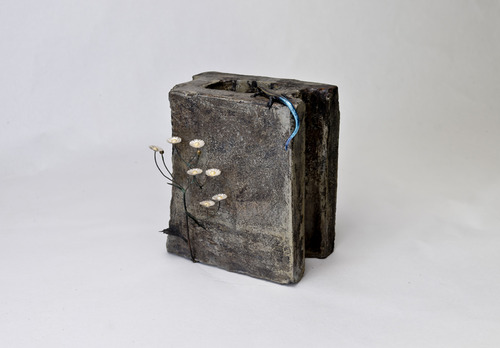
“Scenes.”H190×180×110mm Copper, silver, brass, tin, gold leaf, colored leaf
–I see. How do you decide which metals to use?
As you mentioned earlier, it’s simply whether or not the color can be changed.
Some parts of the metal’s hue are used as they are, but the chemicals that can be used will vary depending on the type of metal.If you can’t use them, you can make each part separately and join them together.

The process of rolling and searing the tin in the vessel on the burner.
Metal can be colored by searing with fire as well as chemicals.
(220They have to keep the temperature at 1.5 degrees or they’ll dull it.)
–Finally, please give a message to everyone who will see your exhibition.
I am conscious of making the most of metal materials, and express colors by the colors of metal materials and chemical changes.
I hope you enjoy the creatures and landscapes expressed by various metals.
Thank you, Professor. Harada!
The solo exhibition is8Month30day(day)We will be holding the exhibition until the end of March. Please come and visit us.
Previous interview is here.
http://blog.livedoor.jp/soratobu_penguin/archives/8759221.html
Takeshi Harada Metal Sculpture Exhibition “Nostalgia
21 August (Gold) to 30 August (Sun)
venue:Gallery Seek
exhibiting artist:Takeshi Harada
Takeshi Harada is a metal sculptor. He creates works using familiar objects such as insects and plants as motifs. His works, which are sublimated from his childhood memories, are nostalgic and breathtaking in their technical precision. We hope you will come and see the new works of the artist, who has been exhibiting energetically in Taiwan, Hong Kong and other countries in recent years.